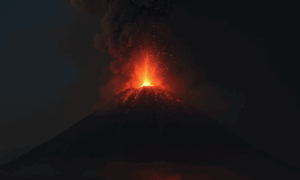JAKARTA  –  On Wednesday afternoon (local time) the Mount Semeru—the highest volcano on the Indonesian island of Java, standing at 3,676 metres—erupted, sending a towering ash plume approximately 2,000 metres above the summit, as local and national authorities mobilised in response.
Located in East Java and roughly 300 kilometres from the tourist hub of Bali, Mount Semeru is part of the Bromo‑Tengger‑Semeru National Park and is known for persistent volcanic activity.
The Eruption and Its Immediate Effects
The eruption was detected in the early afternoon at around 14:13 local time, when the summit suddenly expelled ash and gas in a dramatic event. The geological agency reported that pyroclastic flows—a dangerous combination of hot gas, ash and rock—descended as far as seven kilometres down the slopes.  Simultaneously the ash column reached at least 2 kilometres above the peak, blanketing nearby villages and causing concern for air traffic and local communities.
In response, authorities raised the volcano’s alert status to Level IV (Warning)—the highest category—mandating an evacuation radius of at least eight kilometres from the crater for safety.
Human and Tourist Risk: Who Is in Harm’s Way?
Residents living on or near the slopes of Mount Semeru face immediate danger from falling ash, hot avalanches (pyroclastic flows), and potential lahars (volcanic mudflows). Already more than 300 villagers from three particularly vulnerable communities in the Lumajang district have been evacuated to government shelters.
Tourists and hikers are likewise at risk. A group of 178 people—including climbers, porters and guides—was reported stranded overnight at a monitoring post (Ranu Kumbolo), located 4.5 km from the crater but outside the immediate path of the pyroclastic flows.  Although no casualties have been confirmed so far, the combination of heavy rainfall in the region, unstable volcanic slopes, and ash deposition makes conditions especially hazardous. Local agencies are warning that the rainy season increases the likelihood of secondary hazards such as lahars.
Additional Context: Java’s Dual Threat—Rain & Volcano
In the days preceding the eruption, large parts of Java had been battered by heavy rainfall and flooding, which may have exacerbated the volcano’s instability and increased risks for those living downslope. The rainy season can trigger rapid mobilization of ash and volcanic debris into flows that sweep down river valleys and ravines. Given this backdrop, the eruption’s timing compounds existing vulnerabilities among local people and visitors alike.
What Happens Next?
Authorities are continuing to monitor seismic activity and ash emissions closely. Residents have been told to stay well outside the eight-kilometre exclusion zone, keep away from river paths draining from the volcano, and avoid low-lying settlements in the path of flows. Tour operators have been advised to suspend trekking or tourist access on the mountain until further notice. Meanwhile, aviation authorities are issuing alerts over possible ash drift that could impact flight operations in adjacent regions, including Bali.
Although the eruption appears to have occurred without immediate loss of life, the potential remains for greater danger if the volcano’s activity increases, or if the heavy rain triggers lahars that might flow into populated valleys. Residents and tourists alike are urged to stay alert, follow evacuation orders, and monitor official communications. (zai)

